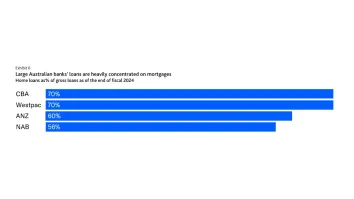
Chinese banks’ new loans may soar by 83%
Here’s how the 4 big banks drive the momentum.
According to Barclays, Market New International reported that new loans for the big 4 banks in the first two weeks of January were RMB270bn. If the figure is accurate and the trend continues, on our estimates, total new loans in January could reach RMB1.2tn-1.35tn, up 62%-83% y/y, which would be consistent with our expectation for strong loan growth in Jan (RMB1+ tn).
Here’s more:
While PBOC has been guiding for banks to pace new loan growth (30%:30%:20%:20% per quarter within a year) in 2011-12, Jan new loan is usually high on seasonality and big banks tend to have higher market share (40%-45%) in the first month of each quarter. This news supports our view that monetary conditions will likely remain loose to support economic growth and be positive for banks’ asset quality in 1H13.
In fact, in previous local news, China Securities Journal (Jan 11, 2013) reported that the 2013 loan quota may be RMB8.5tn and the TSF target RMB16+tn, which are relatively accommodative targets. We continue to recommend staying positive on Chinese bank shares in the near term. Our top picks are BOC, BoCom, CRCB and ICBC.
Big 4 banks’ to lead a strong loan growth in January
The news reported that new loans of the big 4 banks (ICBC, CCB, ABC and BOC) were about RMB 270bn for the first two weeks of January. If the figure is accurate and trends continue, we estimate the new loans for the whole banking system could reach RMB 1.2tn-1.35tn in January, up 62%-83% y/y, assuming the big 4 banks account for around 40%-45% market share of the total new loans.
Strong new loans reported at the beginning of every year
Normally, China banks report substantial loan growth in January, primarily because 1) new loan quota each year stimulates bank credit financing and 2) banks generally prefer to lend at the beginning of each year to earn full-year's worth of interest. In Jan-2010 and Jan-2011, total new loans were RMB 1.4tn and RMB 1.1tn. While in Jan-2012 new loans slowed to RMB 738bn, it was mainly due to the earlier-than-usual Chinese New Year (CNY), which led to only 17 working days in January. If the new loans in Jan-2013 reach RMB1.2tn-1.35tn, it would be consistent with the trends in the past few years (see Figure 1).
Big 4 banks are the key lenders in the first month of each quarter
We note that the big 4 banks have been relatively aggressive in granting new loans in the first month of each quarter. In Jan, Apr, July and Oct of 2012, the big 4 banks accounted for around 40%-45% of the system’s new loans (see Figure 3). We believe it was mainly because the deposit growth at the beginning of every quarter was slow (see Figure 4), which constrained the loan growth of the small- and medium-banks, which have a higher loan-to-deposit ratio.
Monetary policy likely to remain accommodative to support economic growth in 1Q13
The new loan figures of the big 4 banks in the first two weeks of January demonstrated that 1) the overall monetary conditions remain very accommodative and 2) loan demand is likely to be strong in January, which we believe is a near-term positive for the macro-economy and bank NPLs.
In addition, the total social financing in January could remain strong too as recent trends demonstrated (RMB1.6tn in December 2012). However, we also highlight that starting from 2Q13 or mid-year, growth of non-bank credits could be affected by potential tightening regulation on bank off-balance sheet products going forward. We point to 2Q13 and mid-year as the likely timing because the new PBOC governor or CBRC chairman will be on board in March and regulation change will likely follow after the personnel change.
Rapidly growing wealth management products/other nonbank products and recent rising defaults of some of these products highlighted their risk, which warrants more regulation. In fact, regulators have already started initiatives in December such as requiring banks to report statistics on third-party products (trust and PE) sold through their branches and published new tightening regulations on LGFVs’ fundraising methods in late December.



















 Advertise
Advertise










